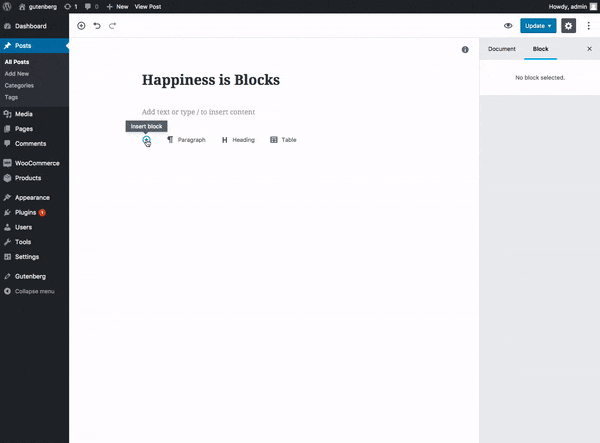The next release of WordPress (5.0) will introduce the new Gutenberg editor and contributors plan to keep it rolling towards the eventual goal of providing a full site building experience. Nearly every WordPress theme and plugin developer will be impacted by the change and many are starting to look ahead to how their products may interact with Gutenberg in the future.
What will e-commerce look like in the Gutenberg era? The WooCommerce design team has published a preview of some of their “Wootenberg” experiments, along with a gif demonstrating what a block-based editing experience may look like in the context of working with products. The team sees a lot of potential for putting the power of visual product editing into the hands of users.
The example shows a quick exploration of page layout with product blocks and the team also posted an idea of what basic product authoring may look like with a predefined product template that includes the featured image, product title, description, and price as new Gutenberg blocks. But will it be possible to have complex product creation fit into a block-based editor? The WooCommerce team admits in the post that they don’t yet know how this will work.
“One thing that isn’t yet 100% clear is how complex plugins like WooCommerce will work with Gutenberg,” Automattic designer/developer James Koster said. “A simple product with a description, a price, and a category is one thing. But a product with variations, for each of which you want to upload a different image, and need to manage/track stock is quite another. Imagining a WYSIWYG editing experience for that kind of data is a little fuzzier.”
Koster referenced Gutenberg’s newly merged support for meta boxes, the first step in making product authoring possible. However, the Gutenberg team is still experimenting and isn’t yet set on a solution for implementing meta boxes.
“How this works with WooCommerce in the long term is unclear,” Koster said. “But you can rest assured it’s something we’ll be dedicating more time to investigating as WordPress approaches the 5.0 release.” Koster concludes the post by asking readers if visual product editing, with the flexibility to rearrange product/shop layouts, is something that interests them.
“If there’s one thing that WooCommerce should perhaps learn from Shopify’s rapid growth, it’s that many ‘would-be’ shop owners don’t care to spend hours upon hours tweaking the layout of their shop, and that pre-built easy-to-use software that looks good and feels good, but can still be extended in complex ways, is what attracts many users,” Jesse Nickles commented on the post. “While this may be the underlying goal of Gutenberg, it perhaps doesn’t crossover clearly to the e-commerce world.”
Koster said he agrees that users don’t always need visual editing experiences and that simple things like price changes should be quick and painless.
“How we present data-driven editing alongside the Gutenberg experience will ultimately determine the success of the project from a WooCommerce perspective,” Koster said.
Support for meta boxes is one the most challenging aspects of the Gutenberg project that the team has yet to solve. Exploring the possibilities of flexible page layouts for products is exciting, but even the WooCommerce team is left wondering how this is all going to work with more complex CMS data. Smaller product teams without the collective knowledge and resources of WooCommerce may have a more difficult time finding the bandwidth to experiment and rebuild their products in time for WordPress 5.0.
The WooCommerce team invites any users interested in Gutenberg-related UX changes to join the plugin’s design feedback group, as they continue to explore how the new editor will work in the context of complex e-commerce product creation and display.

WooCommerce product creation and display is important but so is product search.